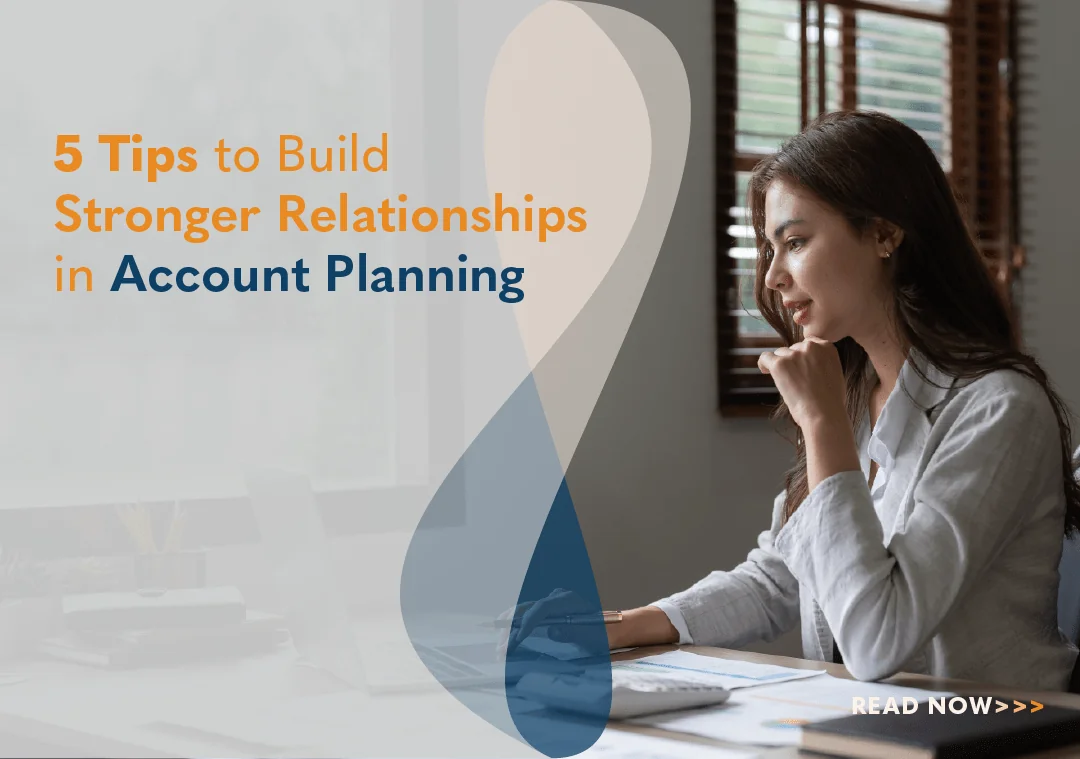5 Tips to Build Stronger Relationships in Account Planning

In B2B selling, we often focus on new accounts. These build business and increase revenue. With that, it’s easy to neglect existing clients. We assume, if they’re buying, they don’t need attention. However, according to Altify:
- Companies receive 60 percent of their sales revenue from existing customers.
- When selling to existing customers, 56 percent achieve win rates greater than 50 percent.
This makes account planning essential. More than upselling and cross-selling, account planning is partnering with existing clients. It’s working together to achieve win-win outcomes. It’s putting their needs ahead of the sale to form long-term relationships. Altify notes account planning has increased from 36 percent of companies in 2013 to 50 percent today. Plus, with account planning, 74 percent see increased win rates.
However, according to Gartner, 51 percent of sales leaders agree account management channels fall short. They do not meet cross-selling and account growth targets. An additional 21 percent are, at best, lukewarm. This leaves only 28 percent who say they meet their targets.
Clearly, sales organizations need to improve account planning. This starts with stronger relationships, key to elevating sellers to trusted advisors. Here, let’s examine some tips to build better relationships in account planning:
Know Your Clients
All sales organizations qualify prospects. This includes knowing their organization, industry, and ability to pay. In account planning, this process must continue. As sales environments shift, so do organizations. Consider the following:
- Research
- Asking the right questions to get beyond surface-level needs
- Active listening
Be up on changes in a client’s business, industry, challenges, opportunities, and expectations. This includes personnel. New employees mean new stakeholders, decision makers, and priorities. To build relationships, you must know who you must know.
Never assume clients will update you. Instead, be proactive. Ask the right questions. Rather than general check-ins, inquire about specific news. Do they recognize the opportunities presented? Also, monitor their sales. If there’s a decline, you need to know why. If they’re holding steady, ask how you can do more. Tailoring your questions to reflect their priorities strengthens your relationship.
Active listening is not only hearing what clients say. It’s deeper, considering the tone, meaning, and feeling behind their words. It’s interpreting body language and nonverbal communication. This uncovers hidden or unrealized needs, central to providing effective solutions. But it’s also critical to relationships. In active listening, sellers invest in the client and participate in their experience.
Build Rapport
Building rapport with clients means strengthening your connection, making your professional relationship personal. For inexperienced sellers, this can mean becoming friends. While close relationships can be beneficial, rapport is more about trust than friendship. It deepens relationships to ensure continued trust. Consider the following:
- Be personable
- Understand the client’s culture
- Personalize
- Instill confidence
Being personable is more than just a friendly smile and quick banter. It’s taking an interest in your client’s life. It’s knowing their favorite sports team and the names of their children. It’s remembering their daughter is a middle school soccer star and spelling bee champ. It’s also central to maintaining a warm and open relationship, the foundation of trust.
For sellers, understanding their client’s culture is key to working with them. Know how decisions are made and your client’s role in the process. Learn about their strongest allies. Leverage your relationship to better understand theirs. This not only aligns interests and gains consensus. It expands networks and forms closer bonds.
Rapport is personal. Your approach to one customer will not be the same as another. This includes how you structure emails, open calls, or customize solutions. Today, personalization is critical. In fact, according to HubSpot, 70 percent of B2B customers expect in-depth personalization. This makes it essential to relationship-building.
According to Gartner, confident customers are 2.6 times more likely to buy. Arm them with the knowledge to make informed decisions. And reassure the wisdom of their choice. When they partnered with you, your client addressed a need and solved a problem. They also invested in their own and their company’s future.
Communicate Effectively
Communication is key to strong relationships. More than what we say. how we say it is critical. Consider the following:
- Be transparent
- Inform, update, and engage
- Maximize the medium
Transparency starts with clear, concise, and consistent communication. Your client knows you’re a salesperson. However, what they don’t know—or can easily forget—is your commitment as a trusted advisor. Demonstrate this with honesty. Put their needs ahead of your own. Push back against quick fixes or short-sighted solutions. Be willing to disagree tactfully for their long-term interest and benefit.
With established relationships, check-ins can become perfunctory. Sellers make assumptions. If communication is great and sales are consistent, all is fine. However, never stop informing, updating, and engaging. Avoid general check-ins with closed questions, such as, “Everything good?” Use open-ended questions to elicit more. Seek new ways to help.
Whether you communicate through email, phone calls, or video, maximize the medium. Of course, video permits eye contact and interpreting body language, which increases trust. But in all, engagement is key. Consider the client’s sense of humor, especially in email and text messages, where tone is essential. Leverage your relationship to communicate effectively. Make the client look forward to speaking because it’s as enjoyable as it is productive.
Deliver Value
For new clients, delivering value is a critical selling point. With established customers, value can be an afterthought. Never take clients—or your relationship—for granted. Even your most reliable clients are susceptible to new offers and new sellers. Continued attention is your greatest value. Consider the following:
- Insights
- Solutions
- Flexibility
Never presume to know more or better than your clients. However, clients can be too close to their situations to see problems objectively. This is a seller’s advantage. Often, more than the products and services you provide, insights build relationships and trust. In account planning, you have a competitive advantage. You know the client. Keep their interests at the forefront and deliver the insights they need.
Products and services are the basis of your solutions. Stay current on both your own and the competition. To provide the greatest value, know the widest selection. And differentiate yours from others, highlighting long-term value over short-term price.
Flexibility is key to relationship building. Often, this involves customized solutions. But this should be more than a one-and-done to close deals. When possible, augment the client’s current products and services. Add value. Make “Thinking creatively for clients” a mindset, not a slogan.
Seek Feedback
A great way to build relationships is to seek feedback. Customers appreciate sellers who care and deal with integrity. And they often welcome the opportunity to help you. Understandably, for some sellers, this can seem salesy. Of course, don’t be a struggling comic, asking the audience, “How am I doing?” Instead, consider the following:
- Surveys
- Interviews
- Testimonials
- Win-Loss Analysis
Surveys can be anonymous or identified, but they should include relevant questions. Also, consider rating scales, such as a Likert. This provides options for participants to rate their level of satisfaction, for example, from one to 10. Also, consider survey tools, such as SurveyMonkey.
Interviews are more in-depth, allowing contributors to expand their answers. Although these require more time, interviews have a greater response rate than surveys. However, sellers themselves might not be the best interviewer. Their closeness can skew the data. Consider higher-level interviews, such as sales leader to sales leader, or qualified third parties like Clozd.
Asking a customer for a testimonial can strengthen your relationship. It says, “We’ve accomplished something great together.” In addition, testimonials can elicit their true appreciation and, indeed, gratitude, fostering stronger bonds.
A win-loss analysis is typically used for new prospects. For example, why you won or lost a deal. However, with existing accounts, it can tell why you only receive some of their business. Invite customers to share. Enlist their support. Make your relationship mutually beneficial. For more, see our blog Tips for Conducting a Win-Loss Analysis.
Let’s face it. In sales, established customers can get the short end of the stick. It’s not a question of their value. Instead, they are typically not as exciting as new prospects. However, the data clearly shows their importance. This makes it essential your account plan prioritizes and preserves these critical relationships. We hope this helps build stronger relationships with your existing accounts, the unsung backbone of your sales success.

- Account Planning (16)
- Awards (42)
- Client Testimonial (37)
- Personal Branding (21)
- Podcast (12)
- Research (77)
- Sales Career Development (90)
- Sales Coaching (165)
- Sales Consulting (141)
- Sales Culture (181)
- Sales Enablement (380)
- Sales Leadership (112)
- Sales Management (268)
- Sales Negotiation (11)
- Sales Prospecting (136)
- Sales Role-Playing (19)
- Sales Training (242)
- Selling Strategies (279)
- Soft Skills (78)
- Talent Management (101)
- Trusted Advisor (29)
- Virtual Selling (57)
- Webinar (13)




























